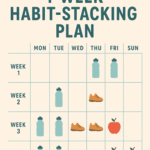It’s one of the most frustrating moments in any weight loss journey. For weeks, or even months, you’ve been doing everything right. You’ve changed your eating habits, you’re moving your body, and the numbers on the scale have been steadily dropping. You feel motivated and in control. Then, suddenly, it stops. For days, or even weeks, the scale refuses to budge.
Welcome to the weight loss plateau. It’s a normal, albeit discouraging, part of the process that affects nearly everyone. But a plateau is not a sign of failure; it’s a sign that your body has adapted to the positive changes you’ve made. It’s a biological checkpoint, and understanding the science behind it is the key to pushing through and reigniting your progress.
Why Plateaus Happen: It’s Biology, Not a Lack of Willpower
When you hit a plateau, it’s easy to blame yourself. But the truth is, your body is an incredibly efficient machine that has evolved over millions of years to survive periods of scarcity. When you lose weight, it triggers a series of powerful, protective adaptations to conserve energy.
- Metabolic Adaptation: As you lose weight, your metabolism naturally slows down. A smaller body requires fewer calories to perform its basic functions. This phenomenon, known as adaptive thermogenesis, means you burn fewer calories at rest than you did at your heavier weight. The very diet that helped you lose the first 15 pounds may now only be enough to
maintain your current weight. - Hormonal Shifts: Weight loss triggers significant changes in the hormones that regulate hunger and fullness. Levels of leptin, the hormone produced by fat cells that signals satiety (fullness) to your brain, decrease as you lose fat. At the same time, levels of ghrelin, the “hunger hormone” secreted by your stomach, can increase. This hormonal double-whammy makes you feel hungrier and less satisfied after meals, creating a powerful biological drive to eat more.
- Unconscious “Calorie Creep”: In response to these powerful hunger signals, it’s common for old habits to slowly creep back in without you even noticing. A slightly larger portion of rice here, an extra handful of nuts there—these small, unintentional increases in calorie intake can be enough to erase your deficit and stall your progress.
How to Break Through: Your Plateau-Busting Plan
Overcoming a plateau isn’t about more extreme restriction. It’s about making smart, strategic adjustments to your routine to outsmart your body’s adaptations.
- 1. Re-evaluate Your Habits: Before making any drastic changes, take an honest look at your current routine. Keep a food and activity journal for a few days. Are you still being as diligent with portion sizes as you were in the beginning? Have any extra snacks or high-calorie drinks snuck back into your day? Often, simply returning to the foundational habits that brought you initial success is enough to get things moving again.
- 2. Prioritize Protein and Fiber: Protein is your best friend during a plateau. It is the most satiating macronutrient, helping to combat the increased hunger caused by hormonal shifts. It also has a higher thermic effect, meaning your body burns more calories digesting it. Crucially, adequate protein helps preserve lean muscle mass, which is vital for keeping your resting metabolism as high as possible. Pair it with high-fiber vegetables to add volume to your meals, helping you feel full on fewer calories.
- 3. Shake Up Your Workout: If you’ve been doing the same workout for months, your body has likely become very efficient at it, burning fewer calories for the same amount of effort. It’s time to introduce a new challenge. Consider the FITT principle:
- Frequency: Add one more workout day to your week.
- Intensity: Try incorporating high-intensity interval training (HIIT) or adding some hills to your walk or run.
- Time: Extend your workouts by 10-15 minutes.
- Type: If you’ve only been doing cardio, add two days of strength training. Building muscle is one of the most effective ways to boost your long-term metabolic rate.
- 4. Increase Your NEAT: NEAT, or Non-Exercise Activity Thermogenesis, is the energy you burn from all the movement you do that isn’t formal exercise—like fidgeting, walking to the mailbox, or taking the stairs. This can account for a significant portion of your daily calorie burn. Make a conscious effort to increase your NEAT by parking farther away, taking short walk breaks from your desk, or pacing while on the phone.
- 5. Master Your Sleep and Stress: Chronic stress and lack of sleep can sabotage your efforts. Poor sleep disrupts your hunger hormones, increasing ghrelin and decreasing leptin. High stress levels elevate cortisol, a hormone that can increase cravings for high-calorie foods and promote fat storage, particularly around the abdomen. Aim for 7-9 hours of quality sleep and incorporate stress-reducing activities like meditation or gentle yoga.
- 6. Look Beyond the Scale: Remember that the scale doesn’t tell the whole story. If you’ve started strength training, you may be building muscle while losing fat. Since muscle is denser than fat, your weight might not change, but your body composition is improving significantly. Pay attention to other signs of progress: Are your clothes fitting better? Do you have more energy? Are you lifting heavier weights? These non-scale victories are just as important.
A weight loss plateau is not a wall; it’s a landing. It’s a moment to pause, reassess your strategy, and appreciate how far you’ve come. By understanding your body’s response and making intelligent adjustments, you can turn this frustrating pause into the launching pad for your next phase of success.




